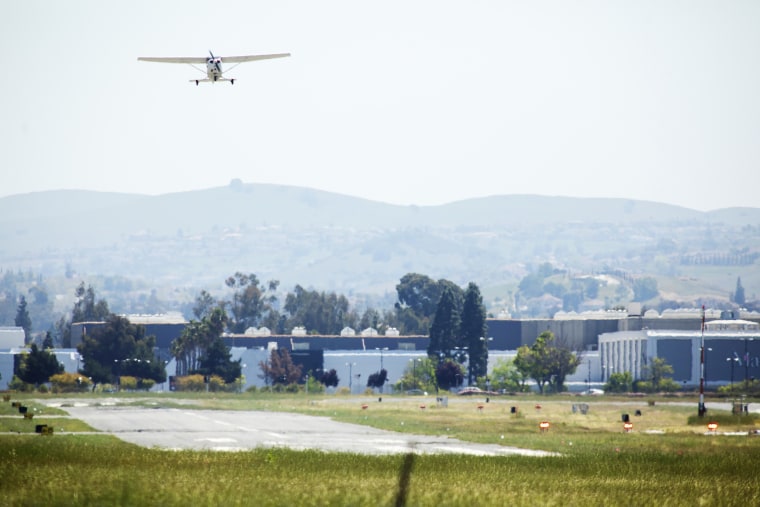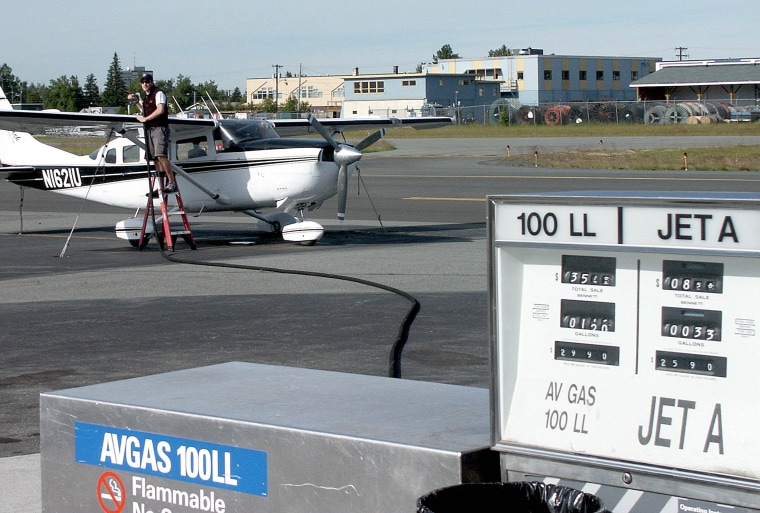SAN JOSE, Calif. — Miguel Alarcon made a habit of wiping down his white Ford pickup truck parked in the driveway of his East San Jose home in California. Like clockwork, a layer of grey film appeared on his car every few days, which he believed was an accumulation of exhaust from leaded-fuel planes flying overhead in and out of Reid-Hillview Airport.
“My car was always dirty from the pollution,” said Alarcon, 42, who lived across the street from the airport from 2014 to 2017.
While he lived there, Alarcon said, he also struggled with respiratory issues. His doctor prescribed antibiotics to treat his breathing problems. But when his sneezing didn’t stop, his doctor recommended he move far from the airport in East San Jose, an area where 2.5 percent of children under 6 years old who were tested had detectable levels of lead in their blood, according to the California Department of Public Health's most recent figures, from 2012. He moved out for a price; his rent jumped from $800 to $1,700 a month.
“The problem is sadly it's very expensive here [in San Jose],” said Alarcon, who earns $5,000 a month after taxes as a roofing contractor. “In the airport area, in each house, there are two to three families because it’s so expensive.”
With rent costing more than $3,200 on average for a three-bedroom home in San Jose, many working-class people like Alarcon have been forced into making a wrenching decision: pay more affordable rent but endure poorer air quality.

That’s because Reid-Hillview is one of 13,000 so-called general aviation airports, from which leaded-fuel piston-engine aircraft fly. While leaded gasoline was fully phased out in 1996 with the passage of the Clean Air Act, it still fuels a fleet of 170,000 piston-engine airplanes and helicopters. Leaded aviation fuel, or avgas, now makes up “the largest remaining aggregate source of lead emissions to air in the U.S.,” according to the Environmental Protection Agency.
The presence of this fuel means the areas near these airports are often inundated with tiny lead particles, according to a 2020 report from the EPA. Lead has been proven to have a detrimental impact on children’s brains and nervous systems.
After 15 years of research, the EPA said it would issue a ruling, known as an “endangerment finding,” in 2018 that would unlock a legal mandate to start driving down leaded aviation fuel. But it has yet to do so.
“EPA will follow the science and law in developing any future decisions regarding lead emissions from piston-engine aircraft,” said Enesta Jones, an EPA spokesperson.
For now, leaded aviation gas appears to be caught in a bureaucratic limbo: stuck between not meeting the environmental demands of the EPA and the commercial realities of the aviation community. It is the primary viable option for this type of aircraft, as the general aviation community argues it remains critical given the needs of the current fleet.
“Fuel and emissions are governed by the federal government,” said Eric Peterson, county airports director with the County of Santa Clara, which owns Reid-Hillview. “So until they come up with an alternative fuel, there is a limited amount the county can do to address that.”

Meanwhile residents continue to live with the air quality that comes with living near an airport where small planes burning leaded fuel fly in and out, said Alarcon, who is also a volunteer organizer with the nonprofit tenant advocacy group Vecinos Activos. It’s also unclear to air quality experts and residents what is arguably safe.
“There is no bright line that says 'Above this concentration lead is safe and below this concentration' that it is not. You’d have to make a policy decision,” said Jay Turner, an engineering education professor at Washington University in St. Louis and member of the EPA’s Science Advisory Board. “We’re really careful to come back to this point that just because public areas might meet the EPA standard [for lead] doesn't mean zero risk or zero concern.”
Long history
Piston-engine airplanes have been a mainstay in aviation since they were first introduced in the early 20th century, according to Walter Desrosier, vice president of engineering and maintenance with the aviation industry group General Aviation Manufacturers Association. Since World War II, piston engines have been widely used by pilot hobbyists, aviation students and government agencies because of their high-performing engines and reliability to stay aloft amid rapid changes in temperature, pressure and altitude. They also cost less at $400,000 to $500,000.
“The type of mission or purpose of using a piston engine might not be served well with a jet,” Desrosier said.
When the EPA first tackled removing lead emissions from engines, it focused on the biggest polluters: cars. At the time, the automotive industry made up the vast majority of airborne lead, with piston-engine airplanes responsible for only about 5 percent of emissions. Technological advances in auto engines, such as cooling liquid, also made way for a new market for unleaded fuel.
But there were no alternatives for piston engines, so they were largely left out of federal regulation.
Piston-engine aircraft are now the largest single remaining source of airborne lead, according to a 2016 EPA study. Approximately one-quarter of the piston-engine fleet are estimated to “consume more than half of all avgas,” according to a January report by the National Academy of Sciences.

Lead fuel users
While scientists, community members and aviation industry advocates agree that lead emissions from these planes are harmful to human health, their users note they play a big role in search-and-rescue efforts, training pilots who go on to fly large commercial jets and filling a recreational market for flying.
Public safety agencies, however, which account for one-quarter of piston-engine planes registered with the Federal Aviation Administration, are “likely to consume more than half of all the avgas used by the fleet,” according to the January National Academy of Sciences report. These agencies often include law enforcement and firefighting aircraft that need to reliably stay aloft through rapid changes in temperature, pressure and altitude. Personal and recreational flyers make up the remaining three-quarters of planes and consume the other half of leaded gas.
For instance, Colorado State Patrol owns five piston aircraft that it uses for flying doctors and state personnel and to carry out law enforcement operations, according to Sgt. Blake White, an agency spokesperson. But the state patrol’s planes are based out of Colorado’s Centennial Airport, where federal workplace enforcement inspectors found “elevated” blood levels of lead in workers and a child who spent time in the repair shop. The agency declined to comment on the findings.
While flight schools, agricultural companies and individual pilot hobbyists also regularly use these aircraft, their owners often agree they wish they could use an alternative to leaded fuel. Jason Jeffery, owner of Pacific Air Flight aviation school, said his school owns seven Cessna 172 piston-engine airplanes to train pilots out of Long Beach Airport. That airport emitted more than 1,500 pounds of lead in 2017, according to data from the EPA. Jeffery said he would switch the school’s fleet to an unleaded fuel alternative if it were reasonably priced and did not require buying new engines.
“There is no option and [lead fuel] is all you can use,” Jeffrey said. “I feel very guilty that we’re burning lead.”
But there are also many white-collar professionals, doctors, lawyers and software engineers who have registered piston-engine planes with the FAA. The Aircraft Owners and Pilots Association, a general aviation professional organization that declined to comment for this article, reports on its website that its members are generally well-off, with an average net worth of $1.6 million and nearly half owning more than two homes.
These users of piston engines say their planes are also put to good use. John McGowan, a board member of the nonprofit Community and Airport Partnership for Safe Operation, is a retired vice president of Agilent Technologies and an advocate for keeping Reid-Hillview Airport open. He said about 60 percent of his flight time in his Piper Comanche 180 is purely recreational. The other 40 percent of his flight hours are what he calls “public benefit,” such as volunteer flying with organizations that transport rescue animals and fly children for free to encourage them to consider aviation careers.
“It’s not about a privilege any more than a fire station or police station or car garage,” he said. “It provides a gateway in and out of the community. It provides a gateway to careers in aviation and a learning gap to students.”
Lead’s dangers
But the Centers for Disease Control and Prevention finds that lead exposure remains incredibly dangerous and that “no safe blood lead level in children has been identified.”
The EPA and FAA began making headway in 2013 with a research and development program to find an alternative unleaded fuel for piston aircraft, given the dangers of lead. But the Trump administration slowed down research into leaded fuel, said Desrosier, of the General Aviation Manufacturers Association.
A study published in 2011 conducted by three researchers from Duke University found that “children living within 500 meters of an airport at which planes use leaded avgas have higher blood lead levels than other children,” with this effect observable out to a full kilometer away from the airport.
Bruce Lanphear, a professor of health sciences at Simon Fraser University in Canada who is also an expert in lead poisoning, said these health effects compound existing disparities between hobby pilots and low-income residents who often live near these airports, since hobby pilots use nearly half of total leaded fuel.
In the case of San Jose’s Reid-Hillview Airport, there are numerous locations nearby where children live and spend time, like a nearby city park, a Boys & Girls Club, a preschool and several schools.

“You have this luxury item that benefits the upper class and is potentially or is harming the minority lower-income populations,” Lanphear said.
Over the last 15 years, the EPA, which is responsible for phasing out leaded gas, has made little substantial progress even when faced with public pressure, according to Marcie Keever, an attorney with an environmental advocacy organization Friends of the Earth. In 2006, her organization fileda formal “petition for rulemaking” to the EPA asking the agency to determine that “lead emissions from general aviation aircraft endanger public health and welfare.” If such a rule had been enacted, that would have kicked off a process to forcefully reduce airborne lead across the United States, Keever said.
While the private sector has made some efforts to introduce newer unleaded fuels for piston-engine planes, lead avgas remains the dominant fuel. That’s because it’s complicated to find a safe alternative to lead in aviation gasoline, and the market is slim for oil manufacturers to offer this type of fuel, said Dick Knapinski, a spokesperson for the aviation enthusiast group Experimental Aircraft Association. To compare, 209 million gallons of leaded aviation gas was sold in 2017, while more than 1.5 billion gallons of jet fuel was sold that same year, according to the Aircraft Owners and Pilots Association.
“It’s such a small market for aviation fuel that it has to be something that the fuel company won’t lose money on,” Knapinski said. “Everybody wants the same thing. We want to find a solution to get unleaded fuel, but it is somewhat complex.”
Still, one notable sign that the EPA may take a more forceful approach is President Joe Biden’s recent nomination of a top environmental advocate to the EPA. Marianne Engelman Lado, an environmental lawyer who worked for Earthjustice from 2010 to 2016 and spearheaded Earthjustice’s lobbying efforts and litigation on the avgas issue, has been serving since February as a deputy general counsel at the EPA. (However, Lado was hired to work in the agency’s Office of General Counsel and not for the Office of Air and Radiation, the portion of the EPA that deals with airborne lead.)
Continued battles
In November, the Santa Clara County Board of Supervisors approved plans to close Reid-Hillview Airport when federal funds expire in 2031. But local recreational pilots and emergency response units that use the airport have raised concerns that its closure will hurt vital parts of rescue and wildfire operations and clog surrounding airports with traffic, according to a local group called Save Reid-Hillview Airport.
McGowan, with Community and Airport Partnership for Safe Operation, said airborne lead rarely exceeds the EPA’s lead emission standards outside of the airport boundaries. He added that the organization doesn’t believe the airport “is a health hazard or safety hazard for the surrounding community.”
“On a safety level, there is no argument to be made that it's a safety hazard for the community,” he said. “It’s been proven it is the safest possible use of the lot.”

Maricela Lechuga, newly appointed commissioner on the Santa Clara County Airports Commission and an attorney with the Law Foundation of Silicon Valley, said proponents who want to keep the airport open are putting their self-interests above the health of local Latino children.
“I understand why they are so passionate about keeping it, but I don’t think it’s worth the expense,” said Lechuga, who advises the Board of Supervisors. “We are in a housing crisis, and maybe that land could be better used.”
Alarcon’s breathing has eased since he moved about 10 miles from the airport four years ago. But he wishes he did not have to move to heal.
“It’s not fair,” Alarcon said. “It's because of them it's so expensive here, and Latino families have to live with the problems with the airport.”
CORRECTION: (April 23, 2021, 09:20 a.m. ET): A photo in an earlier version of this article misidentified the city in an aerial view. It was San Jose, Costa Rica, not San Jose, Calif.

